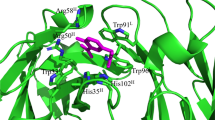Abstract
Proteolytic antibodies appear to utilizecatalytic mechanisms akin to nonantibody serine proteases, assessed from mutagenesis and protease-inhibitor studies. The catalytic efficiency derives substantially from the ability to recognize the ground state with high affinity. Because the proteolytic activity is germline-encoded, catalysts with specificity for virtually any target polypeptide could potentially be developed by applying appropriate immunogens and selection strategies. Analysis of transition-state stabilizing interactions suggests that chemical reactivity ofactive-site serine residues is an important contributor to catalysis. A prototype antigen analog capable of reacting covalently with nucleophilic serine residues permitted enrichment of the catalysts from a phage-displayed lupus light-chain library. Further mechanistic developments in understanding proteolytic antibodies may lead to the isolation of catalysts suitable for passive immunotherapy of major diseases, and elicitation of catalytic immunity as a component of prophylactic vaccination.
Similar content being viewed by others
References
Paul, S., Sun, M., Mody, R., Eklund, S. H., Beach, C. M., Massey, R. J., and Hamel, F. (1991), J. Biol. Chem. 256, 16,128–16,134.
Gao, Q-S., Sun, M., Tyutyulkova, S., Webster, D., Rees, A., Tramontano, A., Massey, R., and Paul, S. (1994), J. Biol. Chem. 269, 32,389–32,393.
Gao, Q-S., Sun, M., Rees, A., and Paul, S. (1995), J. Mol. Biol. 253, 658–664.
Sun, M., Li, L., Gao, Q-S., and Paul, S. (1994), J. Biol. Chem. 269, 734–738.
Sun, M., Gao, Q-S., Li, L., and Paul, S. (1994), J. Immunol. 153, 5121–5126.
Hifumi, E., Okamoto, Y., and Uda, T. (1999), J. Biosci. Bioengin. 88, 323–327.
Hifumi, E., Okamoto, Y., and Uda, T. (2000), How and why 41S-2 antibody subunits acquire the ability to catalyze decomposition of the conserved sequence of gp41 of HIV-1. Appl. Biochem. Biotechnol.
Matsuura, K., Yamamoto, K., and Sinohara, H. (1994), Biochem. Biophys. Res. Commun. 204, 57–62.
McGrath, M. E., Vasquez, J. R., Craik, C. S., Yang, A. S., Honig, B., Fletterick, R. J. (1992), Biochemistry 31, 3059–3064.
Gololobov, G., Sun, M., and Paul, S. (1999), Mol. Immunol. In press.
Rao, S. N., Singh, U. C., Bash, P. A., and Kollman, P. A. (1987), Nature 328, 551–554.
Tyutyulkova, S., Gao, Q-S., Thompson, A., Rennard, A., and Paul, S., (1996) Biophem. Biophys. Acta. 1316, 217–223.
Sun, M., Gao, Q-S., Kirnarskiy, L., Rees, A. and Paul, S. (1997), J. Mol. Biol. 271, 374–385.
Paul, S., Volle, D. J., Beach, C. M., Johnson, D. R., Powell, M. J., and Massey, R. J. (1989), Science, 244, 1158–1162.
Li, L., Kaveri, S., Tyutyulkova, S., Kazatchkine, M., and Paul, S. (1995), J. Immunol. 154, 3328–3332.
Gololobov, G. V., Chernova, E. A., Schourov, D. V., Smirnov, I. V., Kudelina, I. A., and Gabibov, A. G. (1995), Proc. Natl. Acad. Sci. USA 92, 254–257.
Lacroix-Desmazes, S., Moreau, A., Sooryanarayana, Bonnemain, C., Stieltjes, N., Pashov, A., Sultan, Y., Hoebeke, J., Kazatchkine, M. D., and Kaveri, S. V. (1999), Nat. Med. 5, 1044–1047.
Fersht, A. (1984), Enzyme Structure and Mechanism (2nd ed.), New York: WH Freeman and Company, 1–475.
Goodnow, C. C., Adelstein, S., and Basten, A. (1990), Science 248, 1373–1379.
Nossal, G. J. V. (1995), Annu. Rev. Immunol. 13, 1–27.
Paul, S. (1996), Mol. Biotechnol. 5, 197–207.
Warshel, A., Naray-Szabo, G., Sussman, F., Hwang, J. K. (1989), Biochemistry 28, 3629–3637.
Carter, P. and Wells, J. A. (1988), Nature 332, 564–568.
Sampson, N. S., and Bartlett, P. A. (1991), Biochemistry 30, 2255–2263.
Bryant, R., and Hansen, D. E. (1996), J. Am. Chem. Soc. 118, 5498–5499.
Author information
Authors and Affiliations
Corresponding author
Rights and permissions
About this article
Cite this article
Gololobov, G., Tramontano, A. & Paul, S. Nucleophilic proteolytic antibodies. Appl Biochem Biotechnol 83, 221–232 (2000). https://doi.org/10.1385/ABAB:83:1-3:221
Issue Date:
DOI: https://doi.org/10.1385/ABAB:83:1-3:221




